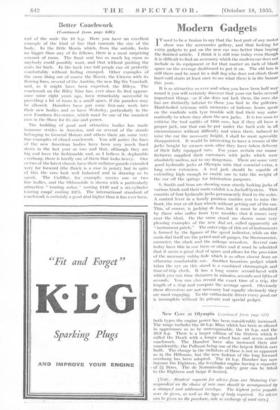Better Coachwork
THERE is a great deal of satisfaction for the eye as well as for the rest of one's body in the new coachwork at the Show. I do not remember any better display at Olympia and not more than one or two in Paris in the days when the first ear body builders in the world took a pride in their work, respected their art and graced ugly chassis with dignity and good looks. The last two or three years have not been really distinguished. With certain notable exceptions, chiefly by the older-established makers, bodies were meant rather to catch the eye than to be inconspicuous. Some were comfortable, some badly designed and very uncom- fortable, perfect examples of the type no coach builder could ever have sat in, many frankly hideous. There were no extremes of folly to which some designers would not proceed in the attempt to make a striking display. The new ones are far better in the practical aspect, bigger and better built, and infinitely more pleasant to look at.
The special coachwork, the kind that is bespoke, does not as a rule change very much or very often. A limousine or big saloon does not offer much opportunity for a decided change of fashion. Inside all manner of details can be added or improver!, comfort enhanced and so on, but the general shape must always be much the same. This year you will detect amid the sober splendours of the coachwork section a definite lightness of touch. Big carriages that you know must weigh the better part of a couple of tons, look half their bulk. Their makers have been clever in the use of shaped luggage boots, shortening and balancing a long body without curtailing the space inside. Hoopers and Barkers, for instance, have two or three really beautiful pieces of work on their own stand as well as on chassis scattered about the stands. For example, the Barker enclosed limousine on the big Rolls-Royce finished in black and chromium outside and walnut inside is a successful example of making a very big carriage in the right proportions. Hooper's " Sports " saloon in dark red and black with sunshine roof, also on a Rolls-Royce chassis, illustrates my point about the use of the, boot. it is well worth while going to the Bentley stand to examine the drop head coupe by Park Ward and the • foni:seater saloon with the fitted suit' cases. Another fine pieCe of Coachwork on the same stand is the " Sports " 'tourer by 'Varidch Plas. It is decidedly one of the most attractive open cars in the Show. Then' there are the cabriolets by Martin Walter shown on Daimler, Lanchester, Vauxhall and Hillman chassis ; the. Tickford foursome 'coupes on :half a doien Vauxhall, Austin,' Crossley, Morris and Armstrong Siddelcy chassis ; and the new Avon bodies on the Standards.
These examples of the special coachwork are representative of the new care which is being taken to combine lightness of appearance with comfort. These qualities are not only shown by our own makers but by several of the continental and American builders. The two Frenchmen, Chapron and Figoni (the former showed the most beautiful open car I have ever seen last year on a Delage chassis) have built some really exquisite bodies, and even the rather stolid German work on the Adler, the B.M.W. and the Mercedes has attractions that are new.
In the same way the standard body - work made by the chassis manufacturers is greatly improved. A typical example is the new big Morris of 25 h.p., and at the other
(Continued on page 612)
Better Coachwork
(Continued front page 640)
end of the scale the 10 h.p. Here you have an excellent example of the kind of line that conceals the size of the body. In the little Morris which, from the outside, looks no bigger than any of its fellows, there is a most surprising amount of room. The front seat has as much leg room as anybody could possibly want, and that without pushing the seats for back. In the back two tall people can sit perfectly comfortably without feeling cramped. Other examples of the same thing are of course the Rover, the Citroen with its flowing lines, several of the Austins, the new Big Six Vauxhall, and, as it might have been expected, the Rileys. The coachwork on the Riley Nine has, ever since its first appear- ance some eight years ago, been remarkably successful in providing a lot of room in a small space, if the paradox may be allowed. Daimlers have put some first-rate work into their new bodies and so have Wolseley, particularly in the new Fourteen five-seater, which" must be one Of the roomiest cars in the Show for its size and power.
The building of gOod and attractive bodies has made immense strides in America, and on several of the stands belonging to General Motors and others there are some very fine examples of clOsed coaeliwork. You will not ice t he lines of the new American bodies have been very Imuch fined down in the last year or two and that, • although they are big and have the fashionable and, as I believe it, deplorable overhang, there is hardly one of them that looks heavy. One or two of the latest chassis have their radiator-guards extended very far forward (the Buick is a case in point), but in spite of this the ears look well balanced and in drawing so to speak. The Cadillac, for example, carries one or two tine bodies, and the Oldsmobile is shown with a particularly attractive " touring sedan " costing 1440 and a six-cylinder touring coupe costing 1375. The international standard of coachwork is certainly a good deal higher than it has ever been.



























































 Previous page
Previous page